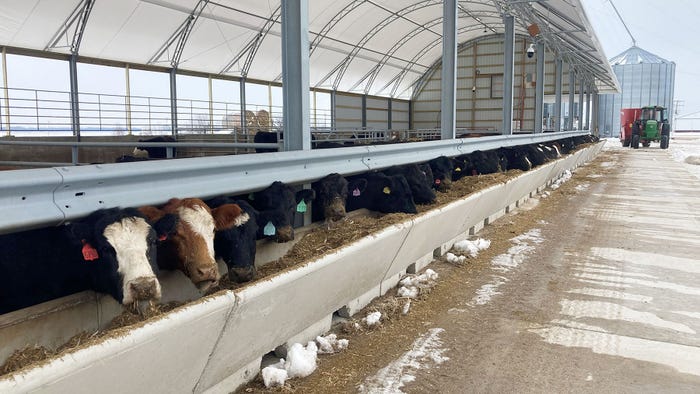
Like a lot of cattle farmers in the Midwest, we run cows because we have rough ground that would wash away if we tried to grow row crops on it — but it makes ideal pasture.
But that also means after decades of raising cattle, we were calving in four different places, in old barns and three-sided sheds, and spending way too many man-hours hauling feed, checking cows, moving gates and treating calves. Plus, as our winters have changed and the ground is less likely to freeze and stay frozen until March, we were dealing with too much mud, losing calves to both mud and disease.
It was time to consolidate those efforts. My husband, John, started researching back in 2022, driving around to check out various buildings, including monoslopes, gables and hoops. He met with builders, got estimates and started formulating a plan.
The result: a 50-by-256-foot hoop structure, built on the same farm as our primary cattle facility and the grain system. That’s also where all the feed, hay and stalk bales are located, and it’s on a blacktop road. All the right things.
We decided on a hoop building because of the airflow and natural lighting, plus it cost a little less than a monoslope or gable. We went with B&B Building Systems, Camp Point, Ill. Total capacity is 100 cows.
Looking inside
For making pens, John found a farmer-owned company in Iowa, Coon River Gate Co., that makes what it calls Enduragates. They’re set in tires filled with concrete, so you can move them and scrape out the building. They’ve also got double hinges so you can swing gates in either direction, which makes for a lot of options.
In writing this story, I asked John if he still liked the gates, and he didn’t miss a beat: “Love the gates.”
He also painted all the gates, guardrails and metal posts with cold galvanizing paint.
Each of the waterers has a little wall around it, so cows have to walk around to the scrape alley side to drink — so they’re leaving manure there instead of in the pen.
John says when the building was full this winter, they scraped the manure alley every other day and bedded twice a week. He found a tire manure scraper to mount on the loader tractor or skid steer, made by Mensch Manufacturing, Hastings, Mich.
The manure holding area is 16 by 36 feet, to comply with the Livestock Management Facilities Act. After the build was engineered, the plan had to be approved by the Illinois Department of Agriculture, in a process that took about three months. The only major change required was that the walls be poured instead of precast, to contain manure and water. That’s a change we’re glad to have made, because the poured walls are stronger.
Prior to building, the engineer had to submit a soil sample to be sure there was enough clay. Then IDOA came for inspections after concrete was poured and again after the building was completed.
Comfortable cows
At capacity, the building holds 100 cows, and we moved the first bovines in just before Christmas. This year in August, we plan to move 30 fall calvers in and bring in the weaned spring calves. We’ll keep both there until the calves sell in December, and we’ll move the cows and calves out to stalks or another location. Then about 100 spring calvers will move in, calve and stay until pastures are fit.
One of the best benefits has been reduced feed intake. John consulted Travis Meteer with University of Illinois Extension about feed rations and quantity, and it turns out cows ate about half as much as before — good news, given that we’d fed so much hay last summer to make up for drought-depleted pastures.
“It just doesn’t take much to maintain a cow in that building,” John says. Plus, we’re limit-feeding, with a lot of straw and cornstalks in the ration. Overall, the cows went through half as much hay, haylage and corn silage.
About the Author(s)
You May Also Like






